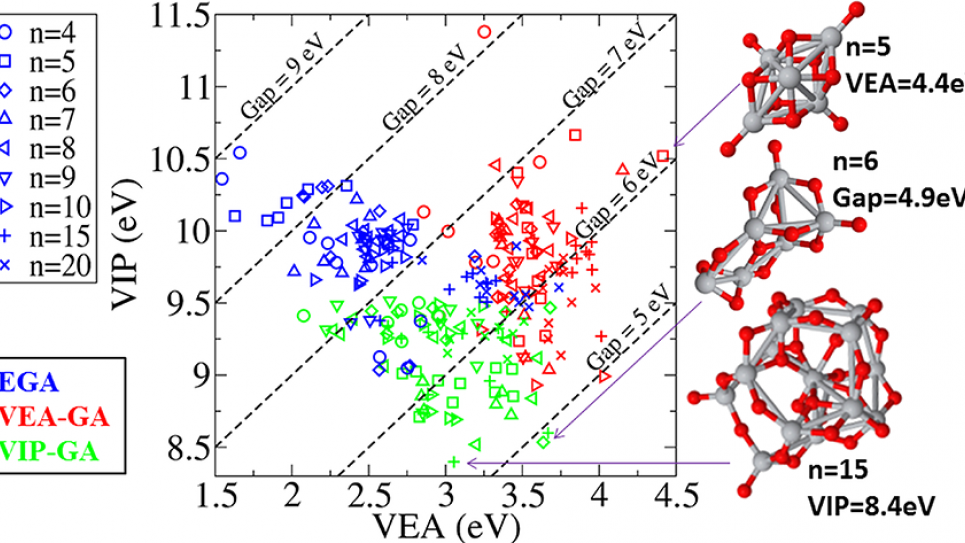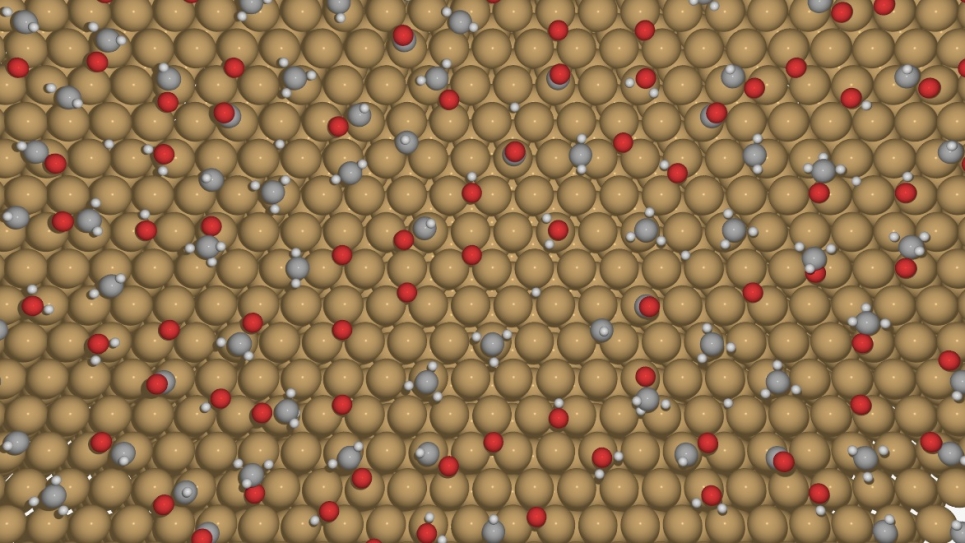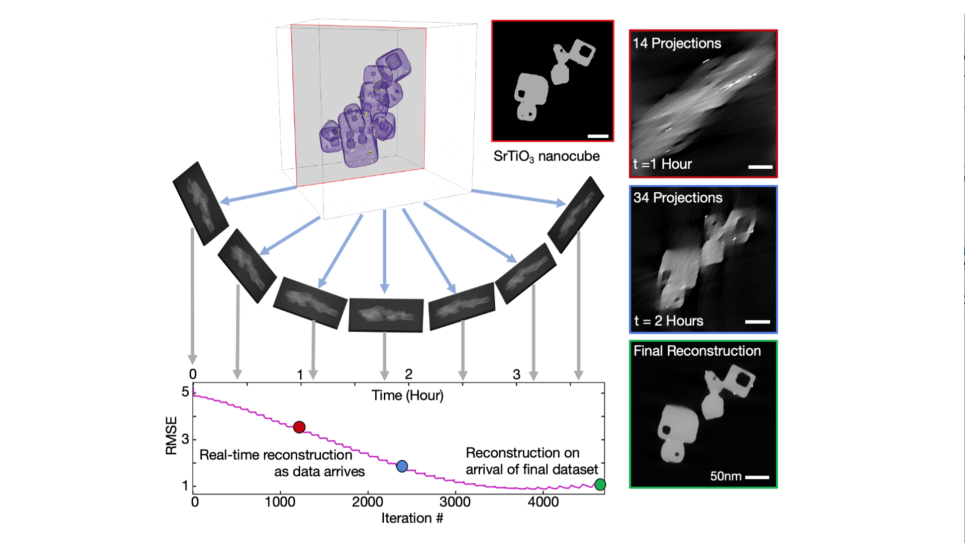
Organics Energize Solar Cell Research
Scientists from Tulane University are using Mira to advance next-generation solar energy technologies by probing the functional interfaces found in organic and hybrid solar cells. ALCF staff helped accelerate their research by enhancing the team’s code so simulations run up to 30 percent faster on the supercomputer.
The sun, that yellow dwarf star at the heart of our solar system, has lit up our skies for nearly 4.5 billion years. Through the process of nuclear fusion, the sun’s abundant hydrogen stores are converted to helium. The energy produced during this process is released, or radiated, beyond the sun’s surface, bathing its planetary neighbors in light and heat.
While Earth receives only a small fraction of this radiation, it constitutes an endless supply of potential energy, energy we have only recently begun to harvest and convert into electricity.
Today, most solar panel technologies rely on crystalline silicon photovoltaic cells. Despite their rise in popularity and advances in energy output over the last 10-15 years, they are still costly to produce, remain bulky and rigid, and employ manufacturing processes that are not altogether environmentally friendly.
As our nation looks beyond its reliance on oil for new sources of fuel and energy, researchers around the world are working to advance these technologies. An international team, led by researchers at Tulane University in New Orleans, is focusing its efforts on organic photovoltaics (OPV) and dye-sensitized, or hybrid, solar cells (DSCs).
The structure of these materials and the processes by which electrical charge is generated are more complicated than in typical single crystal solar cells. To better understand and control the physical processes required for organic and hybrid cells to work effectively, the team is using the high-performance computational resources of the Argonne Leadership Computing Facility (ALCF), a U.S. Department of Energy (DOE) Office of Science User Facility.
"In our case, we don’t just need to design a material, we need to design a functional nanostructure that is made of more than one material and its functionality comes from the combination of materials," explains Noa Marom, assistant professor of physics and engineering physics at Tulane. "You put the materials together to form an interface."
Marom’s team is using ALCF’s IBM Blue Gene/Q (BG/Q) supercomputer, Mira, to study interface properties at the quantum mechanical level, where the functionalities of the interface are determined at the nanoscale.
Organic and hybrid cells are attractive commercially because they are lightweight, more adaptable and potentially less expensive. The current drawback to them is that they are less efficient than standard inorganic cells. While single-crystal silicon cells peak at about 25 percent efficiency—the measure of sunlight converted into energy—organic solar cells currently teeter around 11percent.
One reason is that molecules typically don’t absorb as much of the solar spectrum as silicon, reducing a cell’s initial intake of energy. And unlike silicon cells, electrons must meander through a disordered jumble of molecules or oxide nanoparticles on their way to the electrode, where they can get trapped or lost, further reducing efficiency.
Another, and perhaps, more important reason, is a loss of energy during the process of charge separation, in which bound electrons turn into free carriers, capable of conducting electrical current. This key step occurs at molecular meeting places, or interfaces where, in OPV, donor molecules transfer electrons to acceptor molecules, and in DSCs, dye molecules transfer electrons to oxide nanoparticles.
Thus, the generation of electrical current in OPV and DSCs critically depends on the properties of these active interfaces.
To study this in detail takes not only a powerful computer, but a computer code that can simulate quantum mechanical phenomena on a large scale. In this case, researchers use a code called FHI-aims to simulate the structure and electronic properties of nanostructured functional interfaces.
ALCF assistant computational scientist and chemist Alvaro Vazquez-Mayagoitia is collaborating with Marom’s team to improve its efficiency on Mira, in part, by modernizing the FHI-aims code. By using OpenMP parallelism and leveraging ELPA, a special-purpose vectorized library for parallel dense linear algebra, FHI-aims is able to use the BG/Q hardware more efficiently. These enhancements have reduced the total calculation time by about 30 percent.
Marom’s team also collaborated with ALCF to integrate a workflow manager for BG/Q architecture into the GAtor code, a genetic algorithm (GA) for crystal structure prediction. This development required expertise from a number of teams at ALCF, including the catalyst, performance engineering, and operations groups. Now GAtor can use more than 16,384 nodes concurrently and is accelerating the discovery of new materials on Mira.
Results are already starting to mount.
A recent benchmark study assessed the accuracy of different electronic structure methods (approximations used to apply quantum mechanics to complex systems) for a set of 24 acceptor molecules from chemical families typically used in organic electronics. From the findings, they generated a quantum chemistry reference data set to help describe key parameters for the functionality of these solar cells and predict them reliably.
Another part of the project focused on nanostructured interfaces between dye molecules, which absorb sunlight, and titanium-dioxide clusters that help electrons on their way to the electrodes. Researchers found that by nanostructuring the oxide, they could manipulate the energy difference between the oxide and the molecule.
"The idea there is, you want to have an energy difference that’s really optimal," Marom explains. "It has to be large enough to act as the driving force for charge separation, but not take a big bite out of your maximum voltage. So, interface engineering may be a path to more efficient dye-sensitized solar cells."
The results from these studies will help advance understanding of the quantum mechanics that drive charge separation at these interfaces, improving durability and efficiency.
But for Marom and her team, the outcome is not solely about the development of organic and hybrid solar cells. It is also about the computational processes that help those developments succeed.
"We’re theorists," she says, "so the driving force for the whole field of computational material science, in general, is the science fiction dream that someday we’re going to be able to ask the computer for a material with target properties for some application. The computer will think about it, send the instructions to an atomic assembly unit, and then hand us the material."
Admittedly, it is a process that will take some time. And while the need for better renewable energy mechanisms is imminent, the resources that drive them remain stable. Estimates suggest that the sun will continue to shower us in radiant energy for the better part of the next five billion years.
It appears Marom and researchers like her have a little time to get it right.
Computing time at the ALCF was allocated through DOE’s ASCR Leadership Computing Challenge (ALCC) program.


